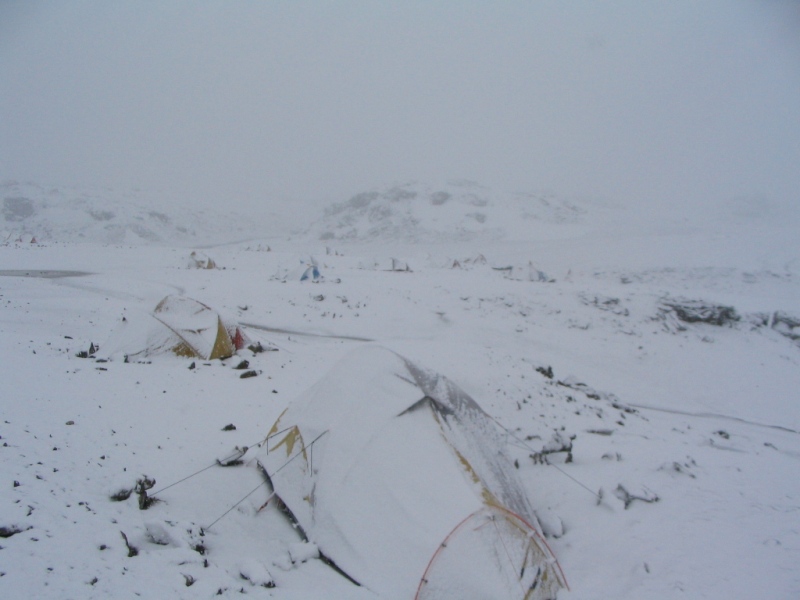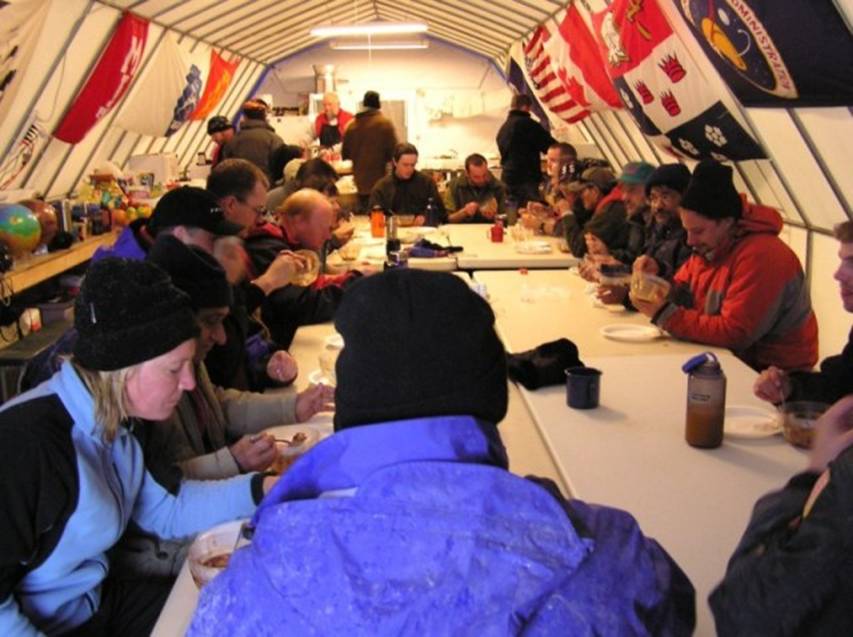HMP e-Logbook
As the field season progressed, the MIT team recorded and posted daily a record of their activities, along with a few selected photos.
The field site's logbook has been duplicated here.
July: 8 10 11 12 14 15 16 17 18 19 20 21 22 23 24 25 26 27 28 29 30 31 August: 1 2 3 4-6
July 20, 2005
Written by Matthew Silver

Upon returning to Cambridge I am considering sending a note to the National Geological Society, or whichever body is responsible for designating climactic regions, asking when Devon Island was label a Polar Desert? Polar—no question (at all); but I am beginning to wonder about the desert part (see above). Seriously though, the wet weather is unusual and has prompted some discussions at camp about climate change and the poles. Apparently most climate models, limited as they may be, predict more extreme changes at the Poles initially. Rather than warming, however, there may be both cooling and wetting. Oz, a geologist who has spent about 7 field seasons here, pointed out that slightly warmer oceans mean the oceans do not freeze over as quickly or as much and that in turn means more moisture up here, which means more snow accumulation, which means more sunlight reflected away from the ground through the spring, and more snow accumulation the next year. Rather than Global Warming, then, this is one plausible scenario for the beginning of an ice-age. Nonetheless this is an extreme patch—things were dry for months before our arrival, and will likely be dry again by the time the other groups arrive. Whatever the case may be, the end result has been a white July 20th. Earlier in the day we had rain and 35knot (~40mph) winds. I took a small movie of this from the newly equipped MIT tent. The file is about 5mb: July 20th, Morning Wind.
In other news, Mike realized that it would make more sense if he leaves Haughton camp tomorrow or Friday, in time for the Saturday flight to Ottawa, rather than next week as planned. The snow means that he may leave Friday rather than tomorrow, but he will likely be on the Saturday flight from Resolute. To paraphrase Paul Erdos, on this trip Mike has been a machine that takes in coffee and puts out computer programs. His applications for the three experiments are complete and he has also completed the all-essential relational database. Later data-entry can easily be completed off-site.
The weather notwithstanding we are therefore well positioned to finish all of our science and reconnaissance objectives for the trip. Today we set up and completed the formal RFID gate experiment. Matt worked out the experiment design, and the hardware configuration and operations side, and Mike worked the software application side. We had ten test-subjects in all, each of whom conducted five different scenarios. The basic goal of the experiment was to bench-mark the differences in time and accuracy between using an RFID system to track goods and using bar-code readers. We also took advantage of the set-up to test variations in the accuracy of the RFID system with respect to antenna number, and item number. While the exact system configuration will of course be different on a real planetary base, these studies will hopefully give some realism to assumptions made about their design. We will convey details of the experiment upon returning. As expected, the accuracy of the RFID system was below that of bar-coding, but the speed was much higher; fewer items were more accurately tracked than more items; and more antennas were, of course, better than fewer. We haven't yet compared the exact data, but roughly it seems that "time wasted" by bar-code does not scale linearly with the number of items—double the items means more than double the time. These results should also be helpful for the design of more comprehensive systems, such as a system to track items as they move from module to module. It is relatively clear that such a system would have myriad benefits, but it is less clear how much one should be willing to pay for it in terms of mass, cost, and overall complexity.
We conducted the RFID gate experiment in the MIT tent, which is newer and therefore cleaner and drier than the Mess Tent. To do this we took down the Mess tent experiment. Below is a picture of Samson, diligently conducting the experiment. The box he is holding includes 20 items, each of which have been tagged and labeled. The gate is composed of four one-watt, circularly polarized antennas, operating at 915mhz and arranged in a rectangle. For now the antennas were installed on tripods, bungeed to the tent roof, and placed in a zip-lock bag on the floor. So much for space-age-looking, I know. But transceiver is as a transceiver does, as they say (or, probably say at MIT at least) .....After walking through the "gate" all participants put the box down, and removed the items one by one.
Upon completing the experiment we prepared for the longer term ATV tracking experiment. This will involve setting up battery activated passive tags along the airport road, and connecting their associated reader to the camp intranet via a portable communications system provided by Steve Braham of Simon Frasier University. Steve runs the comms equipment here at camp, which is part of his research into remote base communications and emergency communications. The main reason for the extra link is that our passive tags radiate at 2450mhz, which could interfere with base comms, so the antennas need to be moved a bit outside camp. Even the 915mhz readers interfered with the safety radios when they passed nearby. These issues are fairly important, and will have to be worked around in the design of the communications infrastructure of a real planetary base. They are also part of the trade-off with developing tracking and logistics management systems that radiate RF although, as a previous post discussed, it is possible to insulate the signal for specific applications.
Besides our work, camp life is going really well. The Humvee is back safely, and only one ATV remains to be fixed. The office tent is now covered and nearly complete, and a temporary food tent went up yesterday. Kimmick has been diligent in his duties as guard dog, and seems to have an uncanny sense of when to sleep and when to appear alert—this basically means he sleeps whenever John Schutt leaves. There are now roughly 33 people on camp, which is nearly double the size from a few days ago. The dynamic has remained good and, if anything, the weather adds to the sense of camaraderie. After dinner tonight Karen McBride from NASA HQ gave a very interesting briefing about recent programs and goings on at headquarters. Below is a photo of the mess tent around dinner.


